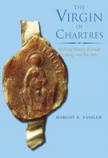Marys Place
The 12th-century cathedral of Chartres truly is one of the world’s great wonders, not only as a magnificent specimen of Gothic architecture but also for the sheer spiritual energy it emanates, a sense of the holy that transcends time, space and creed. Its appeal cuts across the barriers of history and cultures, which in part explains its designation as a Unesco World Heritage site. I first visited Chartres 35 years ago as a studious undergraduate French major and aspiring medievalist. Intending to study the entire town and its environs, I spent most of the nine hours of my available time inside the cathedral itself, absorbing its contents and observing the ever-changing effects of the light streaming in from the stained glass.
The fame and fortune of Chartres is linked to a relic of the Virgin Mary, the Sancta Camisia, the Holy Tunic or Robe. A gift to the church supposedly by Charle-magne himself, it was believed to be the very dress worn by Mary at the Annunciation and the birth of Jesus. Chartres also owed its popularity to another, even more famous Marian relic, strangely and completely ignored in this book: the milk of the Virgin.
Though the Marian cult at Chartres can be traced back to at least the eighth century, it was only in the 11th century that it began to flourish. This was the result of a deliberate publicity campaign initiated by one of the Virgin’s most ardent devotés, Bishop Fulbert (reigned 1006-28). In 1020, on the eve of the feast of Mary’s Nativity (Sept. 8), a fire erupted that consumed most of the town, including its cathedral. The rebuilding of the cathedral was immediately undertaken and finished rather quickly, in 1037. (The present structure represents a later reconstruction following the equally devastating fire of 1194.) At the same time, inspired by the timing of the fire, Fulbert decided to launch a distinctive new image for both town and Virgin by promoting what was one of the lesser Marian feasts, that of Mary’s own birth. In undertaking this campaign, Fulbert may have also been expressing his gratitude to Mary for his miraculous healing. According to the universally believed report of the respectable chronicler-monk William of Malmesbury (d. 1143), Mary had cured Fulbert of some dread illness by bathing his face with milk from her breast, drops of which he dutifully gathered and preserved as a relic for his cathedral (but, again, no mention of any of this in Fassler’s book).
As Fassler explains in her major new study of Chartres:
The elevation of the feast of Mary’s Nativity required a remaking of the past on several fronts. If Mary was to have a birth, then she had to have parents and a set of historical events to indicate the nature of her royal lineage. Mary’s nativity is not described in the Bible, but it required scriptural texts for its foundations.
The historical “data” and scriptural correlations were duly assembled by Fulbert. They were, of course, medieval fantasies, but Fulbert’s eloquence on behalf of Mary, in the form of sermons and liturgical texts, captured the imagination of the faithful and the approbation of ecclesiastical authorities. Reinforced by the efforts of his successors, Fulbert’s campaign was a complete success. The cathedral of Chartres as we know and love it today is ultimately the miracle that Fulbert wrought.
The scholarly core and unique contribution of Fassler’s monumental book is a meticulously detailed study of the development and dynamics of this Fulbertian phenomenon of the feast of Mary’s Nativity through close reading of the materials that created it: above all, the sermons and liturgical texts (chants, responsories, antiphons). In paying attention to these neglected sources of Chartres’s history, Fassler was motivated, and rightly so, by the conviction that in the centuries before widespread literacy, “[m]ost people learned about the past in what they heard and saw and reenacted [in public rituals and ceremony], not in what they read.” For medieval Christians, much of what they understood about history came from the liturgy, including liturgical music. Note that Fassler is professor of music history at Yale and this volume was financed in part by the Yale Institute of Sacred Music; hence, musicology looms large here. (There is, accordingly and understandably, no discussion of Mariolatry—the disturbing excesses of Marian devotion—or of the relevance of the material examined for today’s spirituality.)
The Virgin of Chartres will appeal not only to medievalists and liturgists but to a general readership as well. Do not be daunted by the scholarly apparatus of this weighty tome. Alongside the academic discussions, you will find in easily accessible, pleasurably readable form much of the history, iconography, folklore and nitty-gritty politics surrounding “the Virgin of Chartres.” There are, furthermore, over 100 high-quality black-and-white photographs and 16 excellent color reproductions, a guide to the identification of the statues on the cathedral’s exterior and engaging excerpts from delightful medieval tales and chronicles. If you are a lover of Chartres—and who is not a lover of Chartres even after visiting only once?—there is much in this masterful and wonderfully interdisciplinary new study to inform, delight and illuminate.
This article also appeared in print, under the headline “Marys Place,” in the October 4, 2010, issue.








